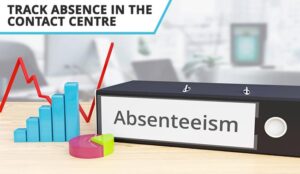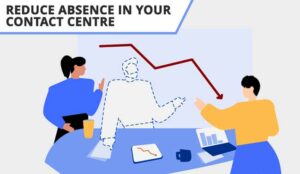High absence rates impact everything from your schedules, to team morale, and customer experience, but even with the best of intentions, sometimes your efforts to reduce absence backfire.
So, what do these common mistakes look like?
Our Editor – Megan Jones – spoke to contact centre experts Clare Santos, Dan Smitley, Jeremy Hyde, Jeremy Watkin and Naomi Smith for their experience of initiatives to avoid at all costs – if you really want to see your absence rates improve in the long run.
5 Common Mistakes That Drive Absence Rates Up – Instead of Down
1. Denying Annual Leave to Try and Buffer Against Unplanned Absences
When you’re heading into peak season and trying to keep as many bums on seats as possible, avoid reducing or even stopping approval of annual leave or paid time off (PTO) – as this will likely drive your absence rates up!

“In my experience, if you try to get rid of one, it just pushes it into the other!
It all comes down to cause and effect, and even if you do have good intentions of trying to control the situation a bit more, your people are likely to just do it anyway – then it’s going to become unplanned leave and put far more pressure on everyone else around them in the long run.” – Jeremy Hyde, Senior Director, Customer Service at Sun Country Airlines
Not only can this approach cost you goodwill and be considered a punishment for the majority (to control the minority), but it can make it far more challenging to have open conversations and negotiate around annual leave.
You could even miss opportunities for shift-swaps and timing adjustments that could ultimately result in a win–win situation.
If you are looking for expert advice on managing holiday and vacation in the contact centre, read our article: How to Manage Holiday and Vacation in the Contact Centre
2. Running a Points-Based System That Only Lets Agents Lose Points – Not Win Them Back
Another common mistake is to set up a points-based system where agents have no control, as they can lose points for being absent – but they can’t earn them back. Sometimes for up to a whole year!

“It’s a lose–lose situation when agents can see they’re in trouble, but there’s no path forward except to wait and hope nothing goes wrong. That’s not a system built on accountability.
That’s a system built on surveillance. It would be far better if leaders shifted that to make point statuses visible in real time, set up clear recovery paths that agents can act on, and let people take ownership – not just take penalties.” – Dan Smitley, Founder of 2:Three Consulting
After all, when agents understand how they can improve their score, they can do something about it, and you’re less likely to see a wave of absences purely related to agents giving in to a downward spiral.
3. Giving Agents a Warm “Welcome Back” Into EXACTLY the Same Stressful Situation
Be especially careful with longer-term absentees, so you don’t send them into a relapse!
Yes, you could have had a friendly Return to Work interview and given them a window of time to catch up on any missed training or admin, before sending them back on the phones – but that can still miss the mark.
As it doesn’t matter how much you try and make them feel welcome if you don’t address the underlying causes that resulted in their absence in the first place.

“Even when agents return well rested from taking a longer break, if the cause of their absence is work related and you don’t fully address the root cause, you won’t prevent it from happening again and you may very well see them taking another leave of absence very soon.
For example, if busy seasonal peaks have been having an impact on their mental health, expecting them to jump straight back onto the floor isn’t going to help anyone in the long run – so dig a little deeper to understand how they feel and what they really need to move forward and DO something about it.
After all, if somebody kept tripping over a chair and breaking their leg, you would remove it, wouldn’t you?” – Naomi Smith, Contact Centre Manager at Worcester Bosch
If you want advice that can help you support your agents and get their day off to the best start, read our article: Hit the Ground Running! How to Help Your Agents Be Shift Ready
4. Expecting Agents to Drag Themselves in for Their Shift – Even When They Are Sick
Absence policies and cultural norms in your contact centre could also be working against you.
If there’s a general mindset that you drag yourself into work even when you’re sick, then it’s going to create bigger problems in the long run – even if the attendance figures do look a bit better in the short term.

“If your agents are sick, don’t expect them to come into work! This really comes down to the culture and policies you have in place, because if someone is worried about not having enough sick days left to still get paid, or has just seen their line manager struggle on with a bad cold, they are more likely to drag themselves in.
Unfortunately, this approach only delays their recovery and increases the chance of spreading the illness to their team – ultimately leading to more absences in the long run” – Clare Santos, Director, Knowledge & Quality, Customer Experience at Aviso
It’s not just your absence rates that suffer either! When agents are sick and trying desperately to struggle on, this also has a knock-on effect on the customer experience. So even though it may feel counter-intuitive in the short term, it’s really so much better for sick people to stay home and recover quickly – so they return to work giving it their best.
If you have high sickness levels and want to get this back under control, read our article: Get Sickness Under Control – 21 Management Tips
5. Believing the Only Way Is to Coerce People Into Doing Their Job
Don’t fall into the trap of feeling that coercing and policing your people is the only way to keep bums on seats. Ultimately, success comes down to taking a more human approach.

“As leaders, I think we often miss the mark and believe we need to coerce people into doing their jobs, when in actual fact, if we can be reasonable, kind, compassionate, and listen to them, we can approach conversations around absence in a far more positive way and foster a culture where it’s actually not so bad to come into work after all.” – Jeremy Watkin, Director of Customer Experience and Support at NumberBarn
What Have You Tried to Keep on Top of Your Absence Rates?
Click here to join our NEW Readers Panel to share your experiences and feature in future Call Centre Helper articles.
With thanks to the following people for sharing their thoughts for this article:
- Clare Santos, Director, Knowledge & Quality, Customer Experience at Aviso
- Dan Smitley, Founder of 2:Three Consulting
- Jeremy Hyde, Senior Director, Customer Service at Sun Country Airlines
- Jeremy Watkin, Director of Customer Experience and Support at NumberBarn
- Naomi Smith, Contact Centre Manager at Worcester Bosch
If you are looking for more advice on how you can reduce absence in your contact centre, read these articles next:
- The Best Ways to Track Absence in the Contact Centre
- The Bradford Factor – Improving Contact Centre Absenteeism
- Tackle the 3 A’s – Absence, Agent Burnout, and Attrition
Author: Megan Jones
Reviewed by: Xander Freeman
Published On: 6th Aug 2025 - Last modified: 15th Sep 2025
Read more about - Call Centre Management, Absenteeism, Clare Santos, Dan Smitley, Editor's Picks, Employee Engagement, Jeremy Hyde, Jeremy Watkin, Leadership, Management Strategies, Naomi Smith, Team Management, Top Story







































